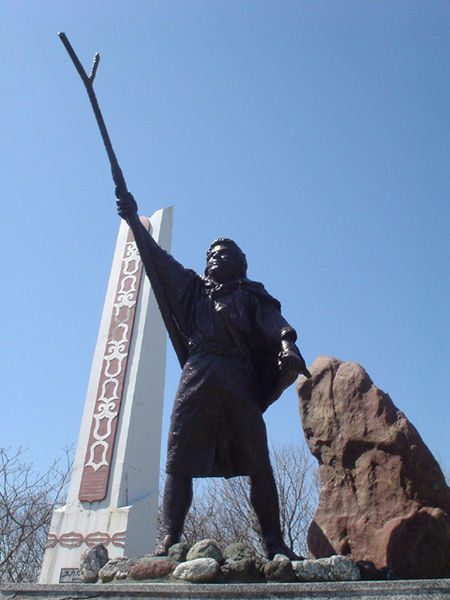Wajin and Ainu relations: History of trade imbalance and exploitation and how “Hokkaido” was born

The history of bilateral trade relations between Ainu and Yamato’s Wa people has shown us that systems of trade imbalance and exploitative practices can lead to an endless cycle of bilateral tension and eventually civil war
Excerpted from Viki Pandit’s “Hokkaido Museum of Northern Peoples’ blogpost
“DECIMATION OF THE AINU
The Wajin as the Ainu called the people from the mainland would often treat the Ainu as inferior. To the Ainu, Hokkaido was their ancestral homeland – the “Ainu Mosir”, but to the slowly encroaching Yamato Japanese, it was Ezo – a foreign land of so-called “hairy barbarians.”
Photo: Ainu Wall-hanging
Hokkaido was then referred to as Ezo (蝦夷) by the people from Japanese mainland – a word made up of two kanji meanings “shrimp” and “barbarian.”
The first major skirmish between Ainu and Yamato broke out in 1457, known as Koshamain’s War. What started as a simple trade dispute regarding a sword was enough to fan the fires of resentment into a full blown blaze of violence. A Yamato blacksmith, enraged by an Ainu customer’s displeasure with the quality and price of the short sword he had ordered, plunged the sword into his young customer.
Seeking revenge, Koshamain, an Ainu leader, lead groups of infuriated Ainu to attack the twelve fortified Yamato outposts on the Oshima peninsula. They managed to defeat the Yamato defenders at many of the forts, sacking them and razing the outposts to the ground. A haunting peace prevailed between the sides until 1668 when Ainu leader named Shakushain launched a war against the Yamato for their interference in local feuds.
He gathered other clans to his cause, using anger at Yamato unfairness as a rallying cry. His army assaulted Yamato towns and took Yamato ships at sea, killing as many as 400 Yamato people. The war became serious enough that the Tokugawa Shogun in distant Edo(Tokyo) sent troops across the sea to assist the Matsumae clan in their battles against the Ainu.
Photo: Ainu Wall-hanging
The eventual outcome of the war was not hard to predict, for the major Ainu weapon was the poisoned arrow while the Wajin fought with firearms. After much loss of life among the Ainu and Wajin alike, Shakusain surrendered. But Japan of yesteryear was not as peace loving as today. The Matsumae solders slaughtered Shakusain and several other Ainu commanders. Not contend with that, they also burned down his fortress.
The outcome of the war was the enlargement of the Wajin domain in Ezo to include all of Oshima Peninsula. Even leaders of Ainu groups that had not participated in the was were made to swear fealty. It was followed by regulations that stunned the Ainu. They were no longer allowed to use metal or sharp edged tools. Ainu were prohibited from raising crops and buying seeds. Many Wajin seasonal workers who came from Honshu for the fishing season temporarily took Ainu women. In 1799 Edo imposed direct rule in the eastern part of the island. Starting 1802, they also started building Buddhist temples in Hokkaido.
Meanwhile, Russian attention towards the Ainu worried Japanese officials, who were concerned about potential Ainu revolts. From 1855, Japanese settlers were officially allowed to move into the Ezochi lands previously reserved for the Ainu and those specially designated military and business enterprises.
In 1868, the Ainu were officially incorporated into the Japanese nation. The incorporation of Hokkaido, which took place without negotiation with the Ainu, was in effect a colonization. During this colonization period, known as Kaitakushi, which lasted from 1869 to 1899, the Meiji government assumed direct administrative control over the Ainu and an official policy of assimilation was begun. It resulted in many legislation against the maintenance of Ainu customs, religious beliefs and language.
To bring the land fully into modern Japan, the Meiji decided to rename the island to separate it from the connotations of Ezo. Matsuura Takeshiro, a Wajin, who was highly revered even among the Ainu, submitted six potential names, including Kaihokudō and Hokkaidō. The government liked the sound of Hokkaido but preferred the kanji meanings of Kaihokudo, and rearranged the former to be read like the latter – thus Hokkaido (海北道, Northern Sea Route) was born.
The first serious blow to Ainu sovereignty landed in the mid-1600s, when a powerful samurai clan took control of Japanese settlements in southern Hokkaido. … snip …
From the 15th century, waves of Japanese settlers began crowding out Ainu communities on Honshu island and pushing them northwards. The settlers also brought infectious diseases that caused Ainu populations to fall. Ainu land was redistributed to Japanese farmers. The Ainu call ethnic Japanese “Wajin”, a term that originated in China, or Shamo, meaning “colonizer.”
Read more about the colonial history of Hokkaido here.
Further reading:
The Octagenarian who took on the shoguns (Smithsonian Institution)

